“Find Your Future”: Creators Wanted Arrives in Freeport, TX
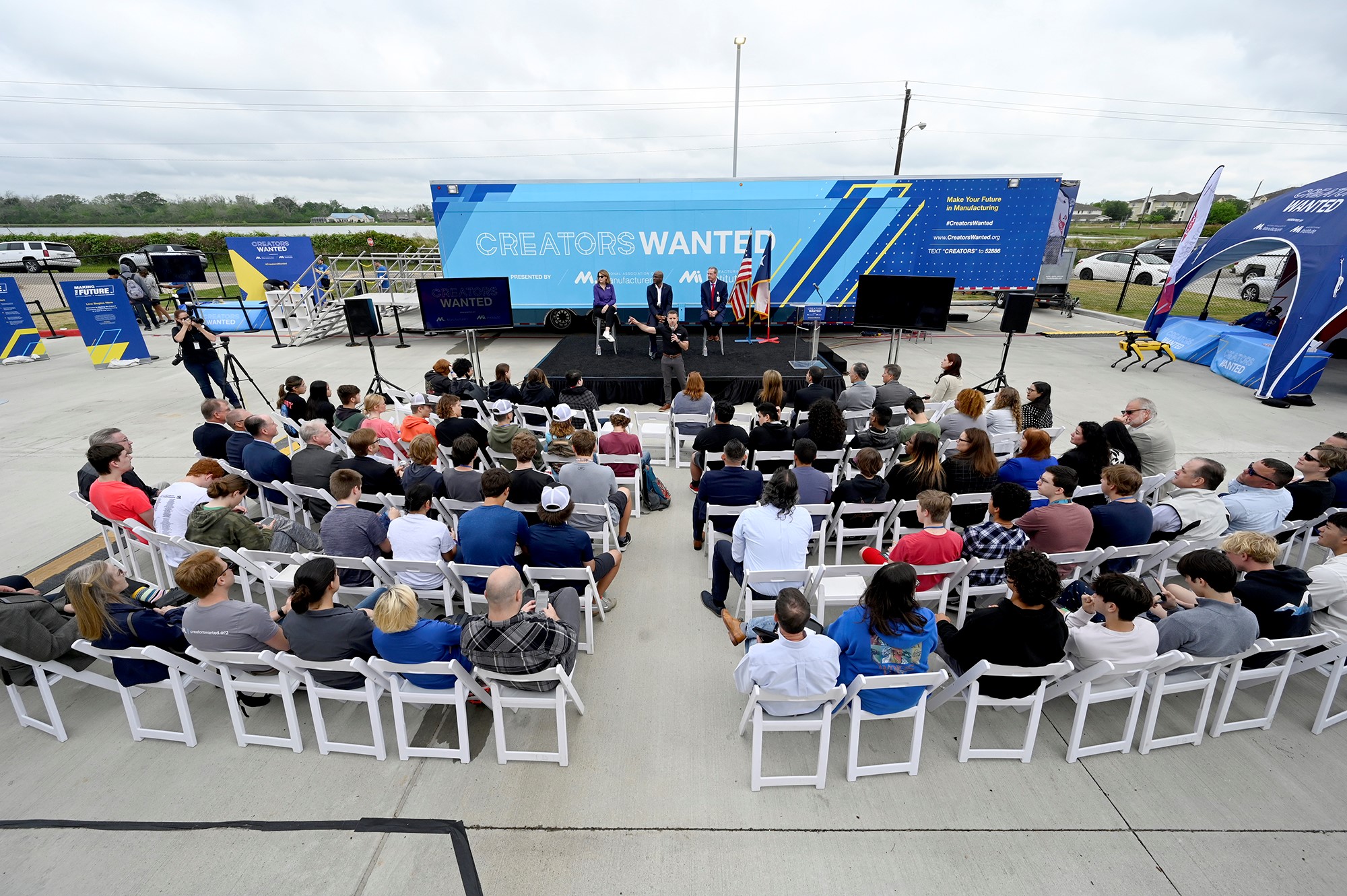
If you want to make a good living, help change the world for the better and have a good time doing it, modern manufacturing has a job for you. That was the message relayed to local high school students this Tuesday at the premier event of the Creators Wanted Tour Live’s seventh stop, in the Freeport, Texas, area.
Inspiring students: The CW tour, a joint project of the NAM and its workforce development and education partner, The Manufacturing Institute, aims to inspire, educate and empower tomorrow’s workforce.
- For this week’s tour stop, presented by Dow, the immersive mobile experience came to Brazosport Independent School District’s Career and Technical Education Center in Clute, Texas.
- The CTE Center, which is located near Dow’s largest manufacturing facility in the world, strives to prepare students for careers in a global economy by emphasizing career and technical education.
- “We believe that the future of our workforce is highly dependent on the quality of public education,” said Brazosport Independent School District Superintendent Danny Massey.
Seeking difference makers: Dow Senior Vice President of Operations, Manufacturing and Engineering John Sampson highlighted the numerous opportunities available in modern manufacturing to do interesting, well-paid, life-changing work.
- “I hope some of you—all of you—will be creators,” Sampson told students at the kickoff event. “At this point in your lives, you’re probably thinking about what you might want to major in. … I’m sure some of you might be interested in making some money, [too,] but you probably want to do more than that.”
- “You probably want to make the world a better place, create something people want [and] have some fun. … I promise you this: We’ll always have a place for you on our team.”
Filling a void: Before the students rushed off to complete their “race to the future” in the mobile experience, MI President Carolyn Lee laid it out for them: Creators aren’t just wanted—they’re sorely needed to keep the world running and advancing.
- “Without a steady stream of talented, bright young people … we can’t keep up the good work of continuously making our products,” Lee said. “[But] this is not a get-one-job-and-stay-there-for-40-years [situation]. This is a choose-your-own-adventure [career path] with continuing skills and challenges and opportunities and learning along the way.”
- There are currently more than 850,000 open manufacturing jobs, Lee said, and by the end of this decade, modern manufacturing will require an additional 4 million workers.
Find your future: “We’re here because we know there’s something for everybody in manufacturing,” Sampson told event attendees in his closing remarks. “We hope you will find your future in modern manufacturing.”
- Dow Vice President of Operations for the Gulf Coast Fernando Signorini echoed his colleague’s sentiment at a Creators Spotlight panel later on Tuesday. “If your desire is to go and get an education in engineering, you’re going to have a lot of opportunities,” he said.
- “If your desire is to have a technical degree, [you’re] going to have a lot of opportunities. For a company like Dow to work, we need all the different … diversities in education and degrees. You see everything in there.”
The impact: More than 750 students are expected to tour the mobile experience this week at the CTE Center, and more than 25,000 students and career mentors in the Houston-metro area have already signed up online to learn more about modern manufacturing careers as a result of this latest tour stop.
Take a look: Check out this highlight reel from the second day of the tour stop.
The MI Gets Funding for FAME
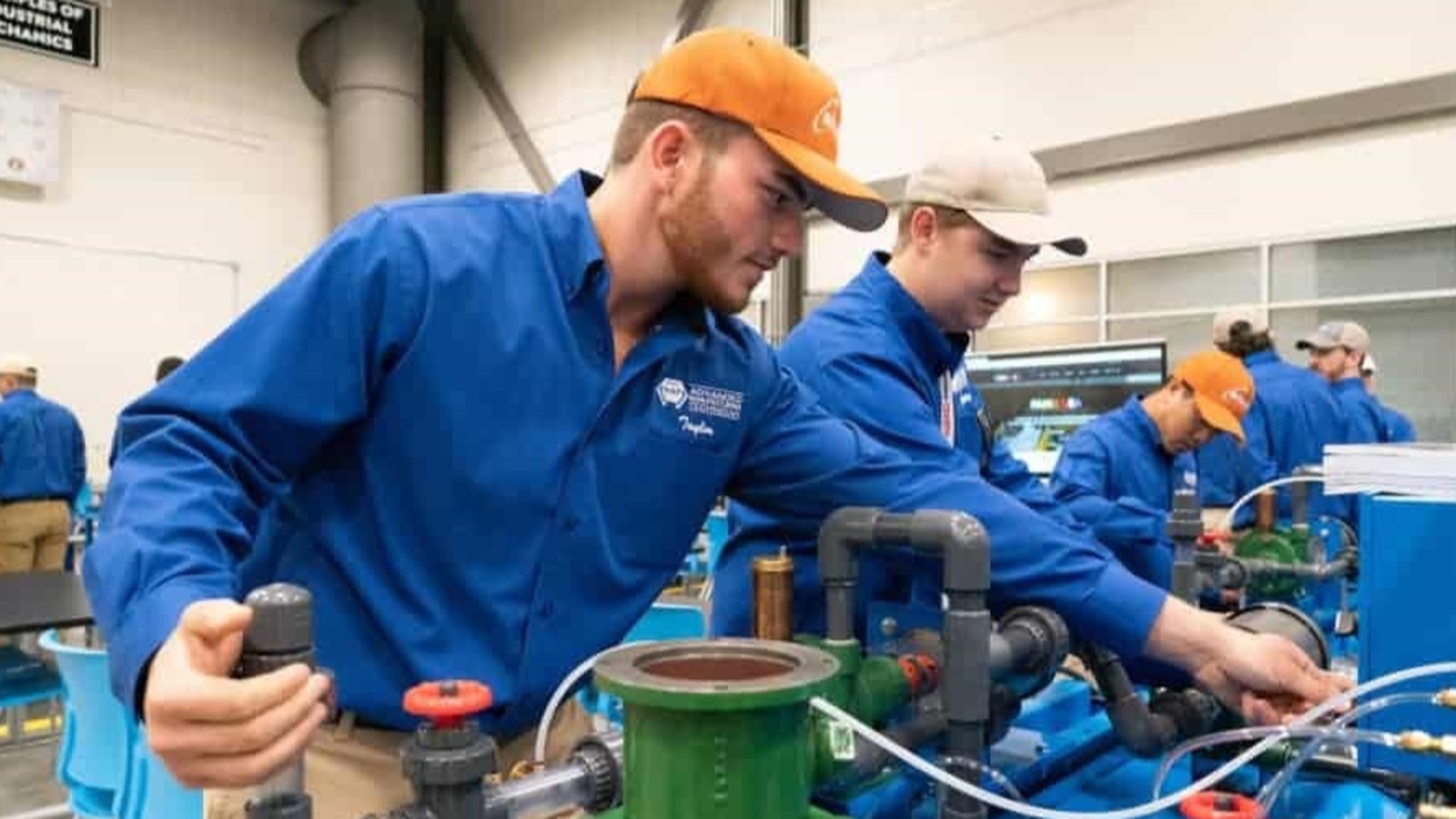
The Manufacturing Institute, the NAM’s nonprofit workforce development and education partner, has been named an inaugural recipient of Stanley Black & Decker grant funding for its “leadership and expansion” of the Toyota-founded Federation for Advanced Manufacturing Education (FAME) program.
The details: The MI, which currently operates FAME, a workforce development and training program, is one of 86 organizations chosen to receive funds from Stanley Black & Decker’s first-ever Empower Makers Global Impact Challenge grant.
- This year’s grants will help skill and reskill approximately 180,000 people in manufacturing through 2022.
- The program will give up to $25 million over the next five years to nonprofits “supporting trade workforce development initiatives in the construction and manufacturing sectors,” according to the MI.
Empowering makers: “Stanley Black & Decker is immensely proud to support the MI through their FAME programming as they work to skill and reskill the next generation of trade professionals,” said Stanley Black & Decker Vice President of Social Impact Diane Cantello.
- “Currently in the U.S., there are an estimated 650,000 open construction jobs and 10 million unfilled manufacturing jobs globally. Our purpose is to support ‘Those Who Make the World,’ and being able to fund educational programs and nonprofits that are revitalizing trade careers directly connects to our core mission. Thanks to this year’s Makers Grant Recipients, together we will be one step closer to closing the trade skills gap.”
The MI says: “Stanley Black & Decker’s commitment to FAME demonstrates how business can lead as they answer the call to grow the workforce of today and tomorrow,” said MI President Carolyn Lee.
- “We are grateful for their partnership in this effort to empower students with pathways to exciting, rewarding careers in modern manufacturing.”
About FAME: Founded in 2010 by Toyota, FAME aims to help students become highly skilled, sought-after makers capable of meeting the unique needs and challenges of the modern manufacturing sector.
Learn more about Stanley Black & Decker’s Empower Makers Global Impact Challenge at EmpowerMakers.com.
i2M Is Meeting Employees’ Child Care, Transportation Needs
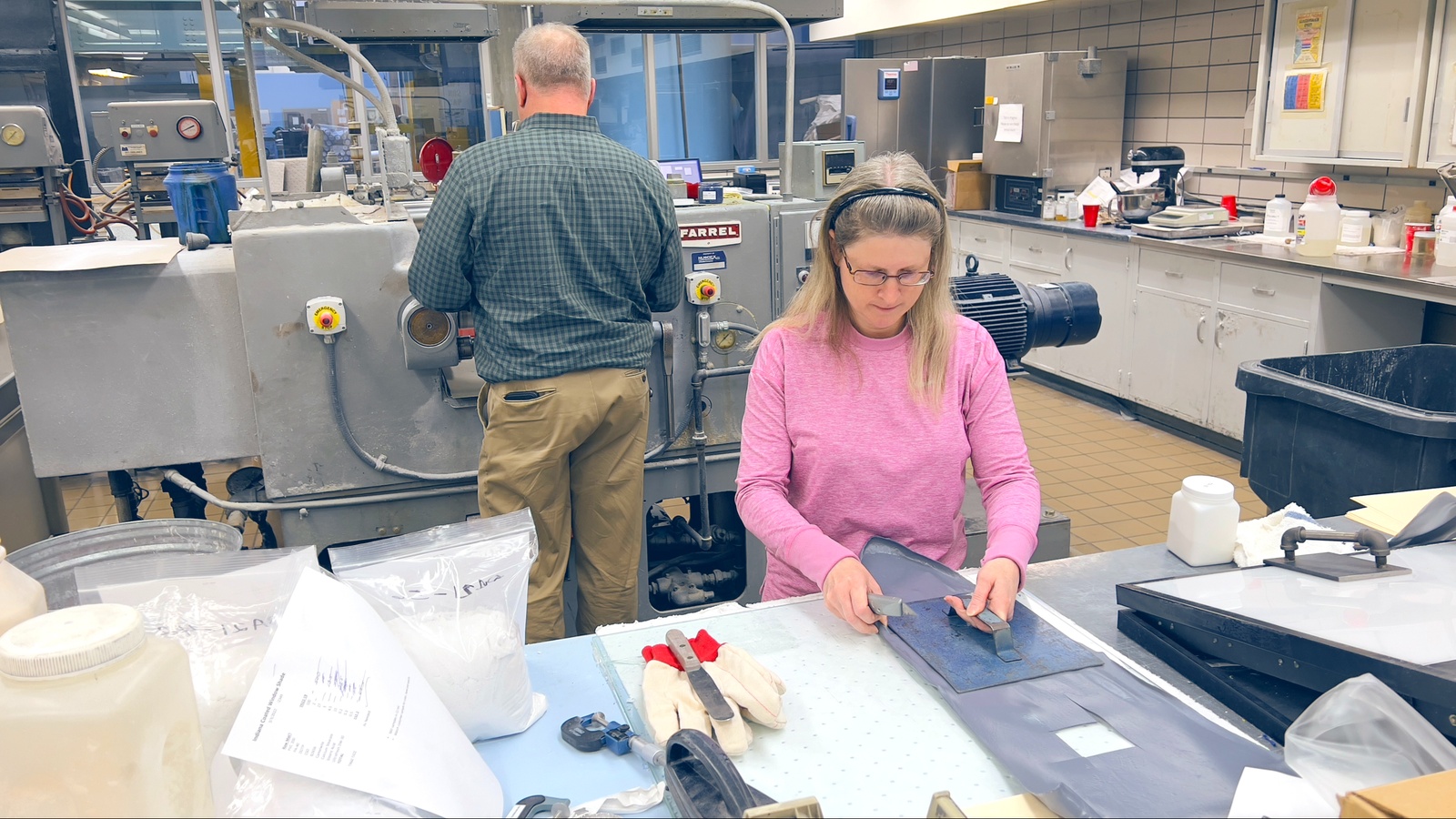
Not many manufacturers can say COVID-19 heralded the start of something great for their businesses, but Alex Grover may be the exception.
At Grover’s company, the Mountain Top, Pennsylvania–based plastics film manufacturer i2M, the pandemic gave rise to two important new employee offerings: Innovation 2 Education (i2E) and Innovation 2 Transportation (i2T).
A pandemic “pod”: To enable employees to keep coming to work when schools closed in early 2020, Grover, who is president of i2M, hired a local school teacher and offered an onsite learning pod for employees’ children.
- The pod endured for several months during the height of the virus’ first wave, enabling i2M team members who were also parents to work and earn money—without having to worry about child care or education.
A larger offering: Yet, as schools began to reopen in 2021, Grover and her team realized the need for child care was not subsiding. In fact, for parents of younger, non-school-age children, it had become even more pronounced than before.
- “People weren’t able to rejoin the workforce—not because they didn’t want to, but because there were new barriers,” Grover said. In families “with two working parents, a lack of accessible child care made it difficult for one parent to work in manufacturing. In single-parent households, it was essentially impossible.”
- Compounding the problem for manufacturing workers is the fact that good care offerings are often only available during the day. “Child care today is typically designed for 9-to-5 office jobs,” Grover said. “In smaller communities like Mountain Top, it is not usually aligned with work that involves 12-hour shifts.”
Changing the face of care: Grover and her team set out to change that. Working with local child care services provider Building Blocks, another woman-owned business in the area, i2M began offering subsidized, extended-hours child care for employees’ kids in January of this year.
- “The goal of developing this program with Building Blocks was, ‘How do we better align the hours to fit with a manufacturing schedule?’” Grover said. “It’s up to businesses to support their team with child care solutions that are a win for all.”
What’s more, Building Blocks is currently considering offering overnight care for the children of third-shift workers.
Gunning for success: Another challenge i2M has set out to solve is an often cited one among i2M employees: transportation. In late 2021, the company rolled out its i2T plan, a partnership with the Institute for Public Policy and Economic Development, to give interest-free loans to i2M team members for car repair or replacement.
- “It’s super disruptive for both the team member and plant operations when a machine operator can’t come in because their car breaks down or they need emergency repairs,” Grover said. “So, we developed the program to provide fast solutions when that happens.”
Thus far, the program has paid out more than $23,000 in 0% interest loans to its team members, who have the principal automatically deducted from their paychecks each pay period.
- Since starting the program, “there have been zero call-offs due to transportation issues,” Grover said.
Next steps: There are plans to expand both i2E and i2T.
- i2M owns a 12,000-square-foot space just up the street from its manufacturing facility and is currently determining how to turn it into a full-time child care center, both for employees of i2M and for other local companies.
- Grover is also working on developing a car-loan program framework that i2M can “roll out to other manufacturers,” she said.
The last word: As Grover put it, “There’s so much opportunity to remove barriers to manufacturing employment. The more people we can bring into the workforce, the greater our ability to deliver results for our customers, our community and the manufacturing industry.”
“Innovativeness” Quotient Is Up, but Perception Work Remains, Survey Findings Show
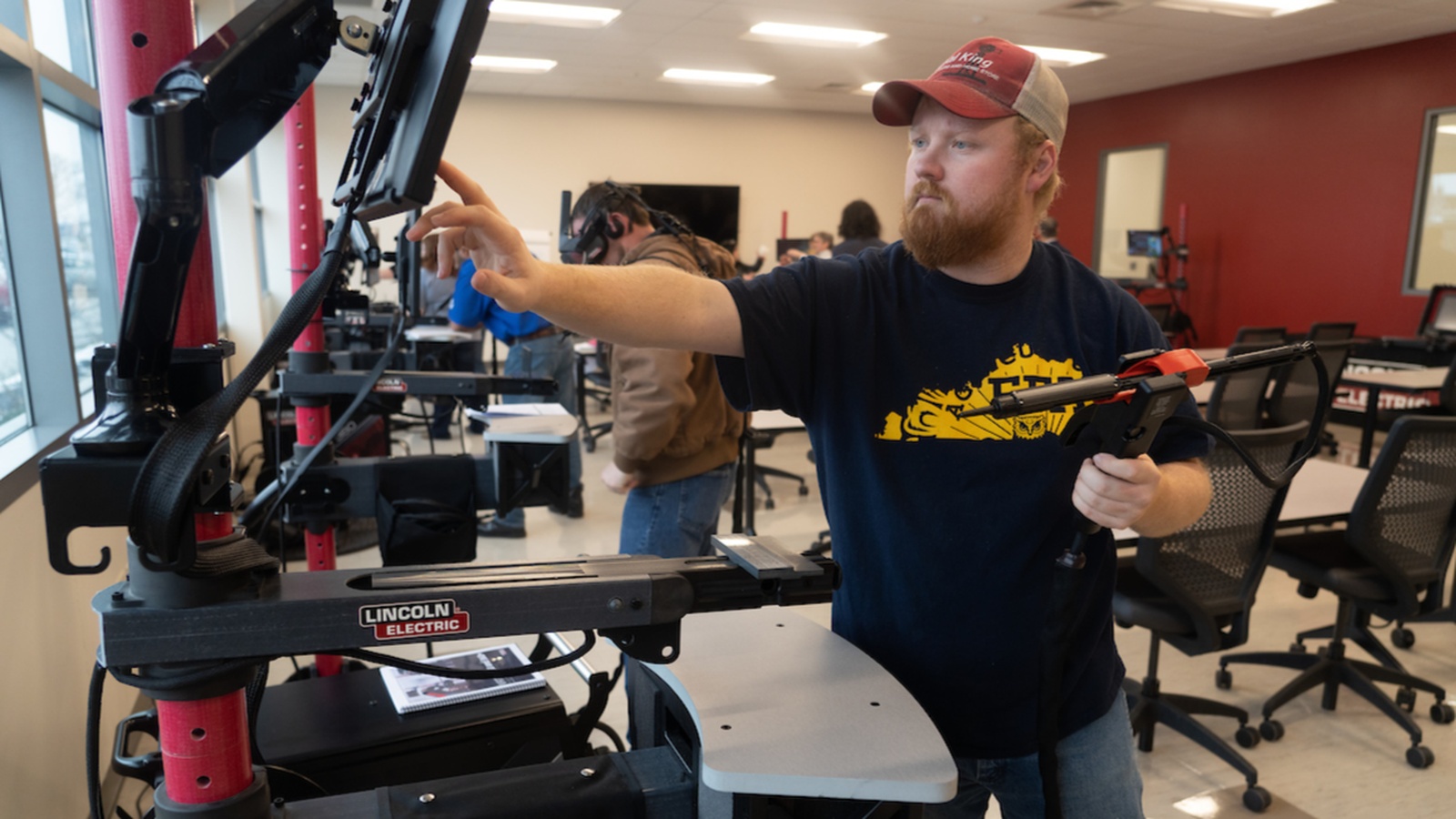
Big gains have been made in recent years in the public’s perception of manufacturing as an innovative industry, but awareness of the sector’s many positives lags, with its labor shortage a continued concern for business leaders, according to a joint Deloitte–MI survey out today.
Key findings: Among the most notable highlights from the study, “Competing for talent: Recasting perceptions of manufacturing,” are the following data points:
- Sixty-four percent of consumers surveyed see manufacturing as innovative, a 25% gain from the 39% reported by respondents in 2017.
- Eighty-three percent of manufacturers surveyed cited attraction and retention of a quality workforce as top concerns.
- Most workers still prefer employment in other sectors, such as retail and services, to manufacturing.
Why it matters: “U.S. manufacturing is at an inflection point: The sector is increasingly viewed as crucial to economic and pandemic recovery, yet outdated public perceptions could be impacting recruitment of vital new workers,” according to the Deloitte–MI news release.
- A continued shortage of manufacturing workers could stymie economic growth and manufacturing competitiveness.
Bright spots: There were several positive takeaways from the findings, however.
- Eighty percent of people surveyed said they might be interested in jobs “with enhanced training and clear career paths,” according to the release.
- The COVID-19 pandemic opened the public’s eyes to the criticality of the manufacturing sector, as it produced much-needed PPE and ventilators.
- Eighty-four percent of manufacturing executive respondents believe their companies are effectively fostering an equitable and inclusive work environment.
The last word: “Manufacturers are working hard to fill open jobs and connect more Americans with rewarding careers, including through efforts like Creators Wanted, the industry’s largest campaign to build the workforce of tomorrow,” said MI President Carolyn Lee.
“As an industry, we are focused on continuing to improve perceptions, so that students, parents, educators and more understand the great opportunities available in modern manufacturing. With new or strengthened initiatives, companies can engage new employees, keep existing employees and bolster their reputations of providing sought-after careers in their communities.”
Spotlight on Scottsdale: Creators Wanted Comes to Arizona
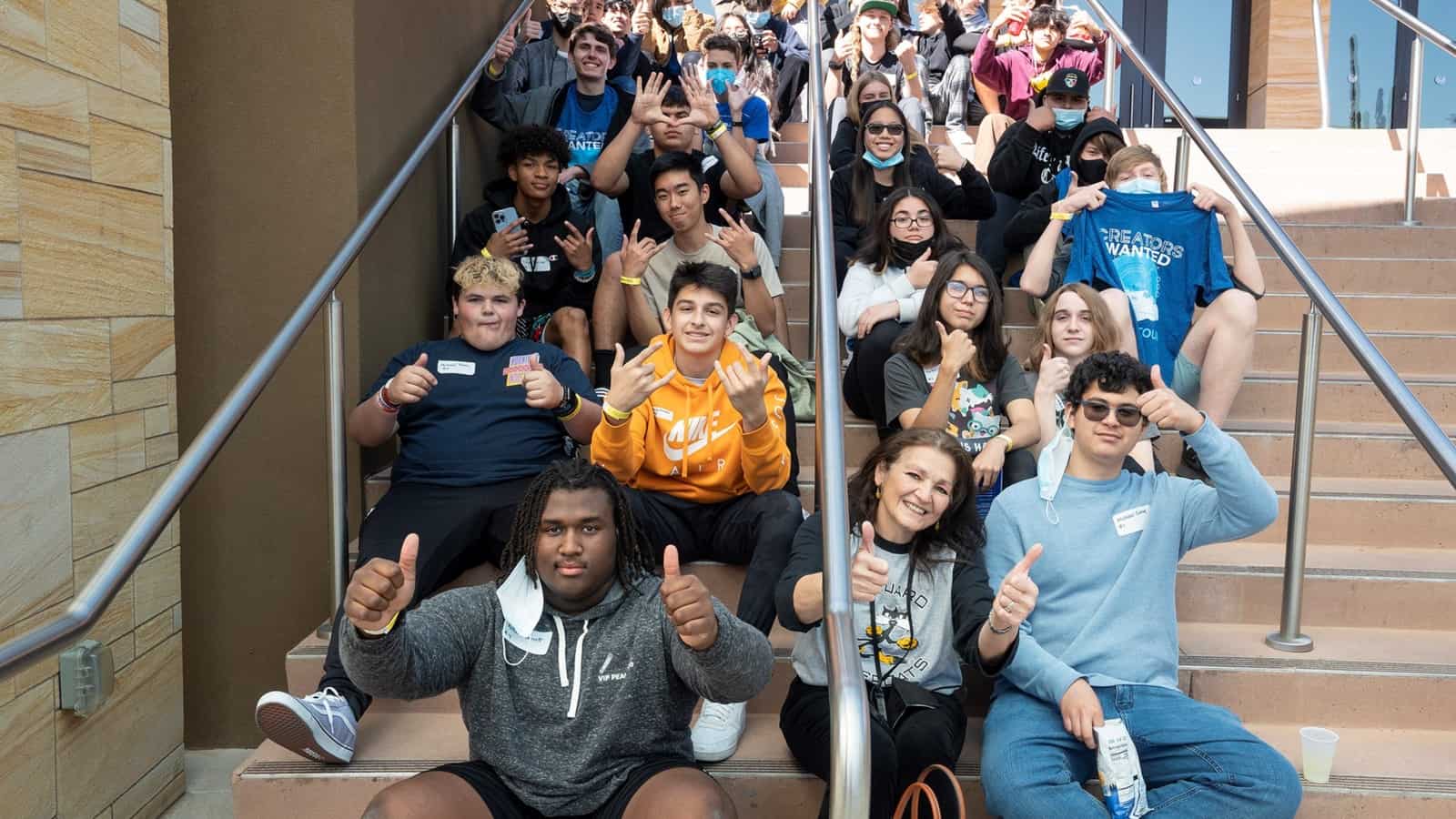
It’s back! Following a four-month break, the award-winning Creators Wanted Live Tour hit Scottsdale, Arizona, this week as manufacturers gathered nearby for the NAM board meeting. The attendee response: pure excitement.
Having a blast: Hundreds of manufacturing leaders and teens from the Scottsdale Unified School District and Phoenix-area YMCA chapters attended the Creators Wanted tour stop.
- Students spent time “racing to the future” in the immersive mobile experience, exploring the information hubs and exhibits by FactoryFix, Benchmark and Thermo Fisher Scientific, meeting and chatting with Maryland Gov. Larry Hogan and more.

Welcome news: The mobile experience, a project of the NAM and its workforce development and education partner The Manufacturing Institute, shared some big news during its stop in Arizona: the president, CEO and owner of Creators Wanted sponsor Nephron Pharmaceuticals Corporation, Lou Kennedy, committed to contribute and raise $1 million for the member-driven initiative to inspire the next generation of manufacturers.
- In recognition of Kennedy’s exceptional leadership in manufacturing, the NAM presented her with the Manufacturing Icon Award.
Big impact: The tour stop in Scottsdale resulted in 25,000 new student, emerging-worker and career-mentor email subscribers—all individuals who will help manufacturers fill the talent pipeline.
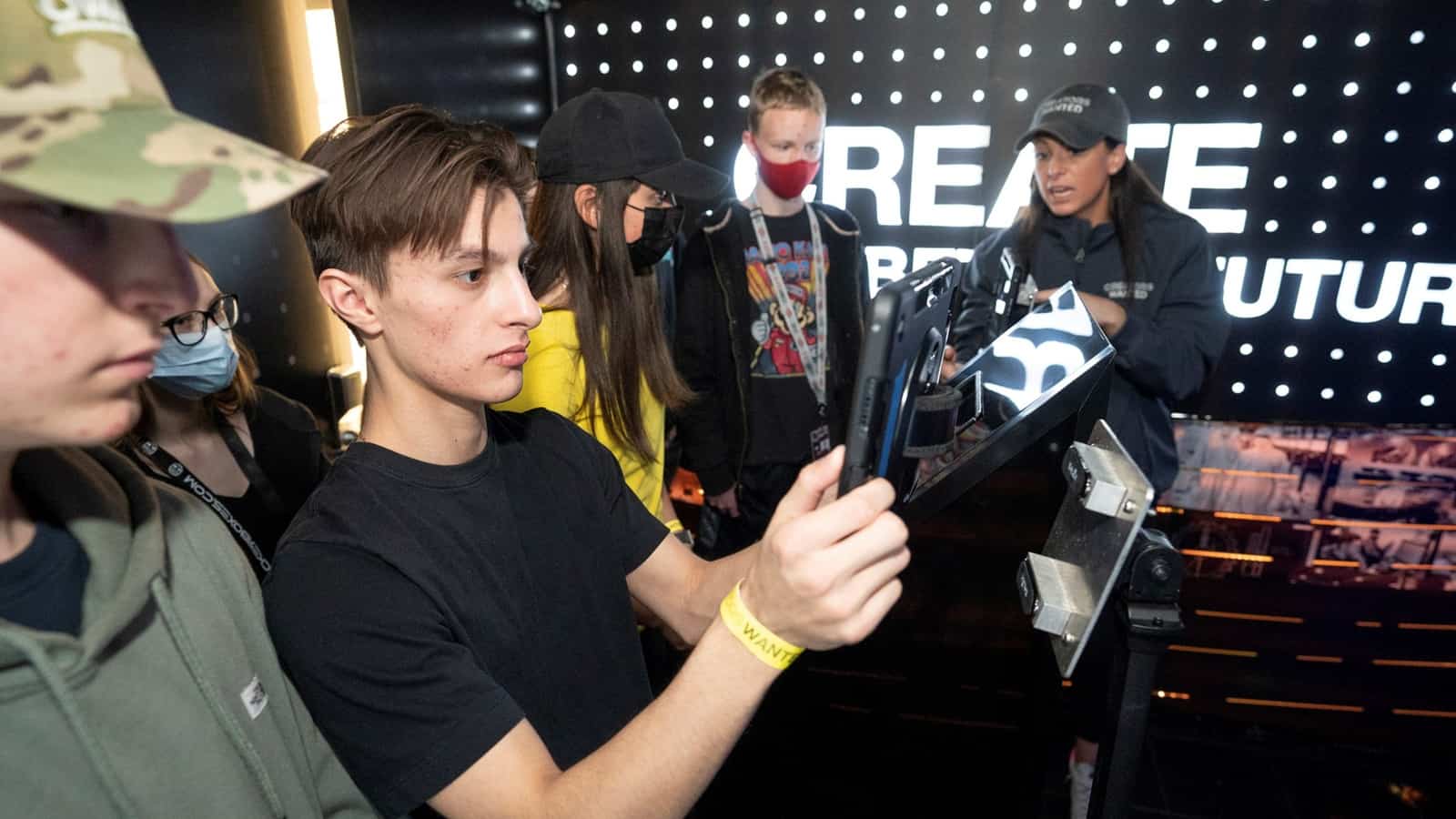
CNBC coverage: Snap-on Incorporated Chairman and CEO and NAM Executive Committee member Nick Pinchuk went on “Squawk on the Street” Tuesday to talk about Creators Wanted and strengthening the supply chain. NAM President and CEO Jay Timmons talked to CNBC the same day.
- “One of the reasons I’m here with the National Association of Manufacturers is because right behind me is our initiative to help fill the skills gap in manufacturing,” Pinchuk said on the ground in Arizona. “One of the problems is [people] view manufacturing as something that other people’s kids do. Well, this mobile interactive unit right behind me is a big factor in that. … It tells you, ‘Boy, manufacturing is not dark, dumb and dirty, as some people think. It’s a cool place to be.’”
- Timmons told CNBC he sees more manufacturing returning to the U.S. from offshore—and that the industry will figure out how to overcome current challenges. “Manufacturers can rise to the solution,” he said. “We always do.”
Op-ed: Timmons penned an op-ed for The Arizona Republic in which he termed the next 10 years “a manufacturing decade.”
- Timmons wrote that for U.S. manufacturing to continue to make “game-changing advances that improve the quality of life for everybody,” Congress must move forward with pending “global competitiveness” legislation, restore “sensible [tax] incentives” that foster research and development and pass comprehensive immigration reform.
What’s next: Creators Wanted stops next in Freeport, Texas, beginning on April 25, presented by Dow. The campaign is also working to raise additional funding to sustain a fall tour in 2022.
Want to join Kennedy in broadening the reach of Creators Wanted? Email Creators Wanted Finance Director Barret Kedzior at [email protected].
Chroma Color Corp. Sees Big Reward in Second Chance Investment
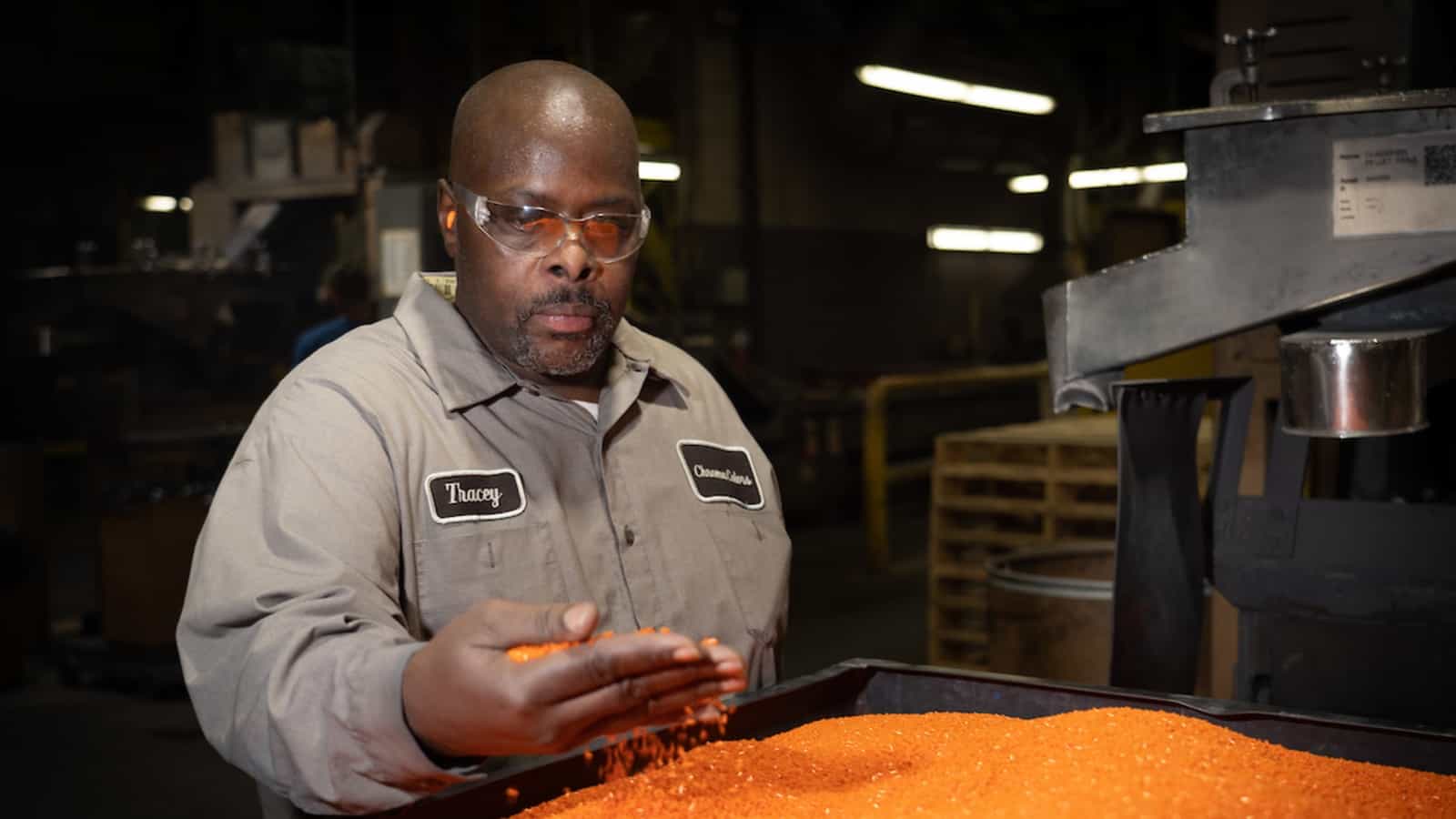
Manufacturers seeking smart, loyal, hard-working employees who are in it for the long haul need to be scouring online career sites and hitting the college job-fair scene with gusto—or do they? Chroma Color Corporation Vice Chairman Matt Barr would say no.
Unusual staff source: Chroma Color Corporation, a 55-year-old specialty color concentrate supplier with facilities in North Carolina, New Jersey, Massachusetts, Illinois and Ohio, has been recruiting talent from a minimum-security prison for more than three decades.
- “For many years, we had a great pipeline” of workers from the Piedmont Correctional Institution in Salisbury, North Carolina, Barr said. “While the program ended with COVID, we’ve decided to rebuild it now that COVID has subsided.”
Staying power: Amid a pan-industry skilled-labor shortage and unprecedentedly high job turnover, Chroma Color hopes for some relief in the form of more second chance employees, who come to the company through a partnership with the North Carolina Department of Public Safety.
- Of the hundreds of second chance individuals who have found jobs at the company since 1990, 90% are still there or have since retired, Barr said. And 100% of those who came on full time have stayed out of the corrections system.
- “We don’t have a lot of turnover,” Barr said. The second chance employees “are very smart and they’re passionate about turning their lives around. People don’t give them enough credit.”
Making the most of an opportunity: Barr attributes much of the low recidivism and turnover to the company’s policy of paying good wages and ensuring that workers have support systems in place.
- The program’s workers “have mentors, so they have contact with people who have gotten out,” Barr said. “They’ve got a model to look at on how to make it work.”
Successes: Stories of second chance employees who have risen among the ranks at Chroma Color and changed their lives completely are many.
- One employee, now the Salisbury plant manager, “did seven years for armed robbery,” Barr said. The man now oversees 25 employees and makes hiring decisions.
- Another second chance staff member, who has been with the company for 17 years, was able to purchase a house just six months after completing his prison sentence. “That doesn’t happen without something like this,” Barr said of the company’s program.
Advice for other manufacturers: Barr, who says the competition for second chance workers is heating up as other companies start to see the state corrections system as potential hiring grounds, thinks more manufacturers would do well to embrace second chance hiring—but only for the right reasons.
- “It’s not cheaper at all, but what you get is a unique workforce that’s dedicated and thankful and devoted and anxious to learn,” he said. “You need to go into it with your heart in the right place and have a genuine appreciation of people. We’ve all made mistakes. [Second chance employees’] mistakes were just a little more costly.”
Manufacturers Unveil Landmark Campaign to Close Gender Gap in Workforce
The Manufacturing Institute Launches “35x30” Initiative to Add 500,000 Women to Manufacturing Workforce by 2030
WASHINGTON, D.C. – The Manufacturing Institute, the workforce development and education partner of the National Association of Manufacturers, announced their “35×30” Women’s campaign, an ambitious, industry-wide effort to close the gender gap in manufacturing.
By 2030, the “35×30” campaign will work to close the skills and talent gap in manufacturing by adding half a million women to the industry, increasing women’s representation in manufacturing from 29% today to 35%. The campaign will also lead a nationwide movement designed to change perceptions by engaging face-to-face with emerging leaders and young women students, leveraging more than 1,000 women mentors and collaborating with manufacturers on strategies to attract and retain female talent and broaden the pipeline by supporting women throughout their education.
“For nine months in a row now, manufacturers have had more 800,000 open jobs, and we can’t make meaningful progress toward filling those jobs without closing the gender gap,” said MI President Carolyn Lee. “The 35×30 campaign is an unprecedented plan to strengthen our workforce and build the talent pipeline. We are thrilled to see the industry unite and recognize the power of women in the workforce. This initiative will help many women of all ages find their way into a successful, rewarding career in modern manufacturing, and I can think of no better day to make this announcement than on International Women’s Day.”
The biggest challenge facing manufacturers continues to be the growing workforce crisis. Studies show that manufacturers can close the skills gap by 50% by bringing 10% more women into the industry. Women account for about half of the U.S. labor force but represent less than one-third of the manufacturing workforce.
As part of the campaign, the MI announced an initial sponsorship of $250,000 from Arconic Foundation to support programs and activities in 2022 and beyond. The MI also recognized Stewards of the “35×30” campaign, stressing their support in narrowing the gender gap facing manufacturing in America.“35×30” Campaign Stewards include:
- Ryan Kish, President and Treasurer, Arconic Foundation
- Dee Dee Fultz, GM of Assembly, Harley-Davidson Motor Company
- Erika Peterman, Senior Vice President, Chemical Intermediates, North America, BASF
- Courtney Silver, President, Ketchie Inc
- Keira Lombardo, Chief Administrative Officer, Smithfield Foods
The “35×30” campaign will add to the MI’s ongoing work to bring women into the manufacturing workforce. Launched in 2012, the STEP Women’s Initiative is the nation’s marquee program to close the gender gap in manufacturing. STEP consists of the STEP Ahead Awards and professional leadership development program as well as regional STEP Forward events throughout the year. The initiative works to foster a 21st-century manufacturing workforce by elevating and inspiring women in the manufacturing industry through recognition, research and leadership, as well as by motivating alumnae to pay it forward by mentoring the next generation. Click here to learn more about the “35 x 30” campaign.
-The MI-
The MI grows and supports the manufacturing industry’s skilled workers for the advancement of modern manufacturing. The MI’s diverse initiatives support all workers in America, including women, veterans and students, through skills training programs, community building and the advancement of their career in manufacturing. As the workforce development and education partner of the NAM, the MI is a trusted adviser to manufacturers, equipping them with resources necessary to solve the industry’s toughest challenges. For more information on the MI, please visit www.themanufacturinginstitute.org.
State of Manufacturing: Resilient
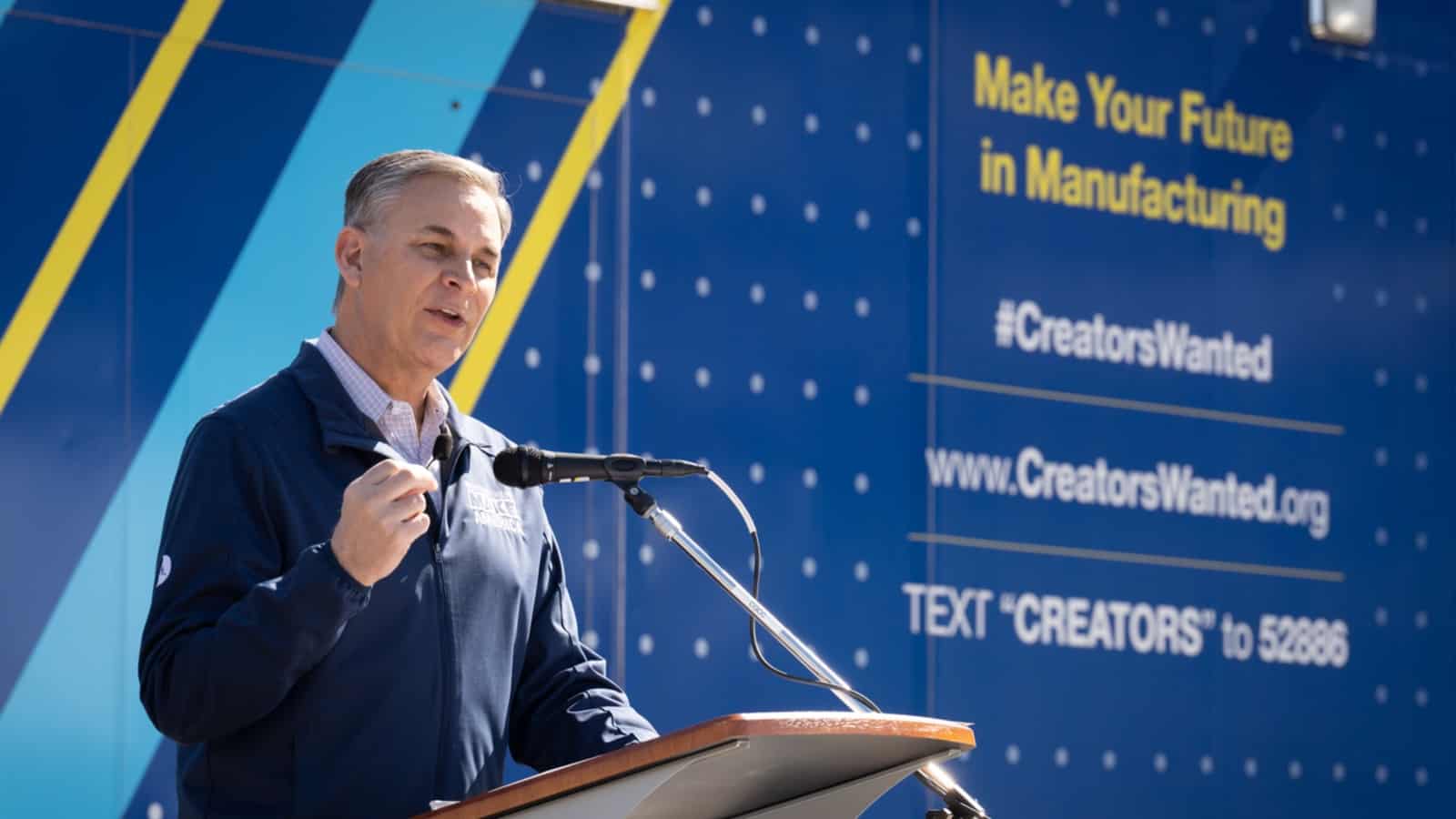
Workforce inspiration, COVID-19 safety, sound legislative policy, tax reform and democracy—these were the main themes NAM President and CEO Jay Timmons discussed during the NAM’s State of Manufacturing address Thursday at Chandler-Gilbert Community College Williams Campus in Mesa, Arizona.
Inspiring the workforce of tomorrow: Manufacturing is a high-tech, fast-paced, well-paying place to work, Timmons told the audience as he stood before the Creators Wanted Tour Live mobile experience, an initiative of the NAM and its workforce development and education partner, The Manufacturing Institute. But, he said, the industry has not been immune to the labor shortage.
- “For each of the past nine months, manufacturers in America have had more than 800,000 open jobs in our industry—800,000 chances to launch a well-paying career,” Timmons told the audience of college students, teachers and staff, as well as local manufacturers. “In Arizona, there were more than 11,000 openings in just the first 45 days of 2022.”
- Yet the state of U.S. manufacturing is, Timmons announced, resilient. “There’s hardly ever been more opportunities for future manufacturing workers. Innovators. Designers. Technicians. Creators. We’re a $2.57 trillion industry, with more than 12.5 million workers and counting. And the vast majority of manufacturing leaders say they are optimistic about the future.”
Getting policy right: Timmons also talked about the policy landscape and stressed the need for lawmakers to enact robust supply-chain, immigration-reform and competitiveness measures.
- “If we’re really going to outcompete China and other countries, then we need Congress to finish up the ‘global competitiveness bill’ they’re working on and get it to the president,” Timmons said.
- He added that coming legislation must include measures to bolster supply-chain resilience, combat goods counterfeiting and increase domestic semiconductor manufacturing.
“Rocket fuel” required: Following the passage of tax reform in 2017—which Timmons called “rocket fuel for our economy”—manufacturers have “kept our promises to raise wages, hire more workers and invest in our communities,” he said.
- “For more than a year, some politicians have tried to raise taxes on manufacturers,” Timmons said. “They tried it with the COVID-19 relief bill. They tried it with infrastructure. They tried it with Build Back Better. And three times, manufacturers said don’t do it. And we won. The voices of moderation in the Senate prevailed.”
- “But if tax reform is repealed or punitive measures, such as the ‘book tax,’ are passed, the U.S. economy will suffer,” Timmons said.
Safeguarding values: America’s values and institutions are what have made manufacturing possible, Timmons said, and we must defend them from the threats they now face.
- “Today, America faces new threats to our democracy, including those threats from within,” Timmons said. “And once again, manufacturers stand proudly on the side of protecting and preserving American democracy and our constitutional republic.”
Media mentions: News of Timmons’ address was picked up by national outlets including POLITICO Pro’s Morning Trade and Fox Business, and an op-ed by Timmons ran on Cleveland.com.
Point of emphasis: “I’ve always believed, and the past two years have reinforced, that manufacturers are in the business of causes greater than self. From building the arsenal to win a world war decades ago, to pioneering the treatments to defeat today’s diseases and pandemics, we change the world,” Timmons underscored in the wrap-up of the address.
Read Timmons’ full remarks here. Learn more about the Creators Wanted campaign and encourage students in your networks to RSVP for its Scottsdale, Arizona, showcase on March 7 here.
Engaging Historically Black Colleges and Universities in the Talent Search: Tips for Manufacturers

For Tonya Byrd, there was never any great conundrum about where to attend college.
No question: “I was raised in that HBCU mindset,” said the Howard University alumna and director of community engagement policy and local affairs for Dominion Energy. “It was not a question for me of where I wanted to matriculate and learn and grow.”
MI webinar: Byrd shared some of her own academic and professional experiences as she joined Intel’s Chris Ross for a recent Manufacturing Institute webinar on how manufacturers can best engage historically Black colleges and universities.
- Byrd and Ross, who lead HBCU engagement at their respective companies, agreed on three main strategies manufacturers can employ to bolster their diversity and inclusion work and attract African American talent in a tight labor market.
Build relationships: A manufacturer doesn’t have to have huge sums of money to successfully engage HBCUs and their students, Ross and Byrd said.
- “We’re finding there are a lot of ways you make … meaningful pathways happen” between HBCUs and manufacturers, Ross said. “And it doesn’t require big paychecks to happen. We’re looking at, ‘Can we just set up some Zoom calls or Teams calls where we bring in some of our engineers … and they talk about what it’s like to be an engineer at Intel?’”
- Headquartered in Richmond, Virginia, Dominion Energy sits strategically close to many HBCUs on the Atlantic coast—but location isn’t everything, Byrd said. Dominion has African American resource groups through which it creates mentorships with students at local HBCUs, and this is something other manufacturers can replicate no matter where they may be located, she said.
- “We’re building [those] relationships by offering what we have as well as listening,” she said. “It’s, ‘What do you need?’”
- Dominion has also reached out to graduate and Ph.D. students at Howard University’s Department of Economics for third-party, independent research purposes. “Students get cases studies and get to know the company” that way, she said.
Leverage alumni: Those who attended HBCUs and are now in the workforce are frequently a manufacturer’s best bet when it comes to recruitment.
- Intel has relied on HBCU-alumni employees to help forge relationships with key schools, Ross said. “That’s one way to start with the engagement.”
- For Dominion, alumni are a primary connector to HBCUs. “Alumni and their networks” are key to keeping open communication between the company and the schools, Byrd said.
Be a meaningful place to work: Manufacturers should recognize that younger generations of workers and those coming out of college now want something different from employers than previous generations.
- “There’s a different mindset in [those] coming into the workforce now,” Ross said. “They care about environmental sustainability, they care about their communities, they want to stay local.” To that end, manufacturers should ensure they have sound corporate social responsibility programs in place and “be vocal about your shared values.”
- The opportunities to guest lecture and mentor students at their alma maters seem to “really be driving employee engagement” and retention, Byrd said. Employees “find that rewarding. They get to give back to their community.”
- In addition, manufacturers should be vocal about their support of justice, Byrd continued, adding that Dominion leadership came out with a statement condemning the murder of George Floyd soon after the event. That C-suite move had a profound impact on employees, Byrd said.
The last word: Manufacturers of all sizes and types can be successful at HBCU engagement—and it will be well worth their time. “The HBCUs are gems,” Byrd said. “They are pillars in our community. What better place to look to grow innovation?”
Lincoln Electric Invests in Workforce and the Future
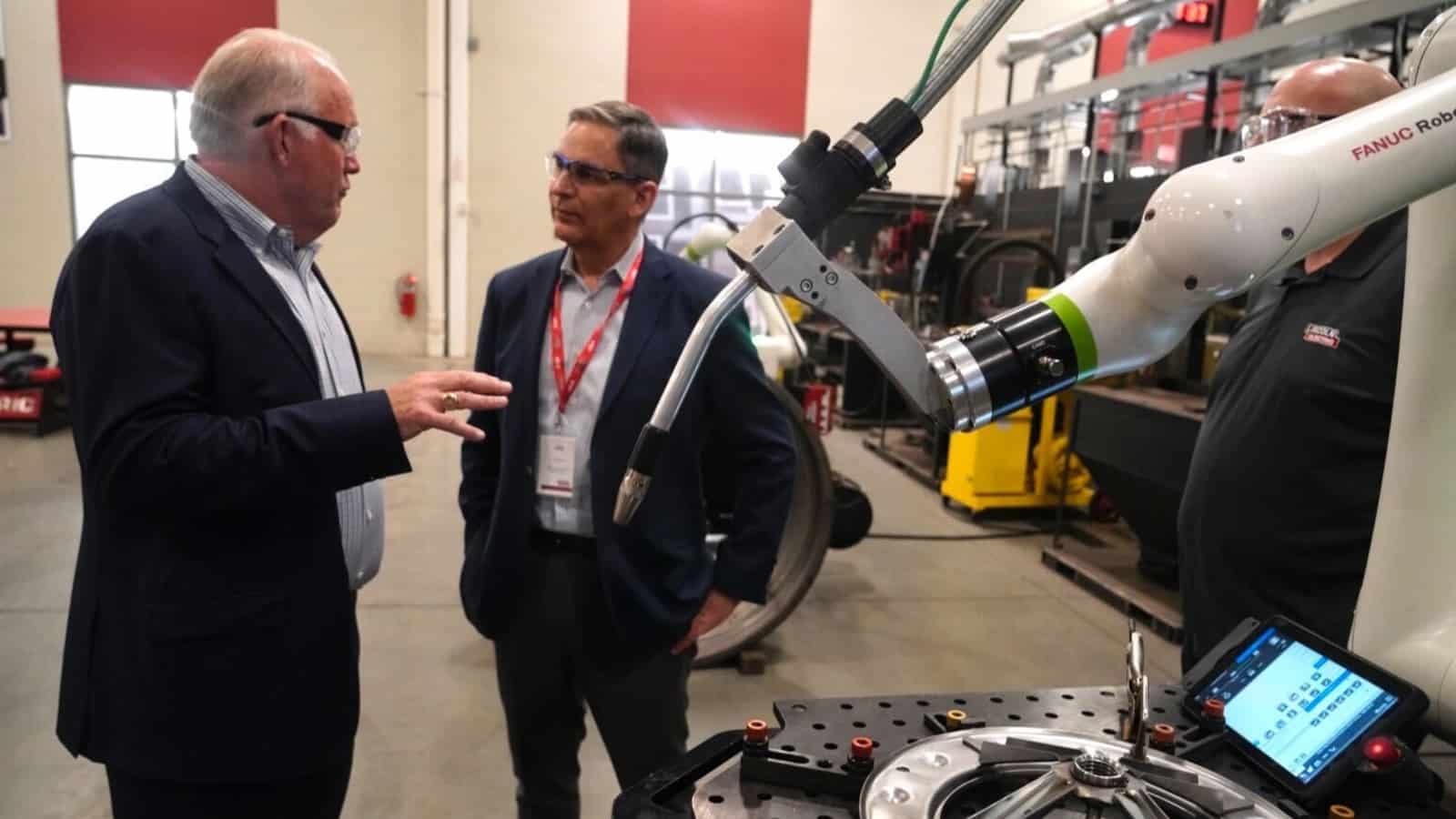
Ahead of Thursday’s 2022 NAM State of Manufacturing Address, NAM President and CEO Jay Timmons was in Cleveland, Ohio, where he visited Lincoln Electric—a global manufacturer of welding products and equipment—to discuss the state of the industry.
Trailblazing training: At Lincoln Electric, they’re not just operating the longest continually running welding school in the world. They’re also offering cutting-edge tools for new students and making sure that the people who come through their training center are well prepared for the world of tomorrow.
Welding Technology and Training Center: At the WTTC, participants learn in a $30 million state-of-the-art facility designed to help train students for new careers and to upskill welders to take on new roles and responsibilities.
Virtual Reality Welding Solutions: Not all training needs to happen in the real world. The VRTEX® virtual reality arc welding trainers offer high-tech learning solutions for students and professionals alike, along with learning tools designed specifically for educators.
A helping (bionic) hand: Finding skilled welders can be tough. However, plenty of jobs in the welding industry don’t come with a steep learning curve. To help expand their workforce and improve productivity and efficiency at their facilities, Lincoln Electric has invested in collaborative robots that offer easy automated assistance with a simple, user-friendly interface that non-welding professionals can use.
Strengthening supply chains: One challenge for manufacturers throughout the pandemic has been the burden placed on international supply chains, which has caused long delays and uncertainty around shipping. Lincoln Electric has the only wire-based additive manufacturing factory in the United States for 3D-printing large metal-based industrial components, replacement parts, tooling and molds—products that have traditionally been cast and sourced internationally. Through their innovation and domestic production, they can create parts in days or weeks that would otherwise take six months or more to build.
Lincoln’s line: “We are pleased to welcome Jay and the NAM team to Lincoln Electric and have the opportunity to showcase our industry-leading workforce training and development solutions, as well as innovative automation and large-scale additive solutions that address the manufacturing sector’s need for added operational capacity to drive growth and shorter, more reliable supply chains,” said Lincoln Electric Chairman, President and Chief Executive Officer Chris Mapes.
Our take: “From the management that has built state-of-the-art training facilities to the employees who have used that training to build a rewarding career, this is an example of a team that is more than the sum of its parts,” said Timmons. “It was energizing to see all the incredible work that Lincoln Electric is doing to invest in its workforce and the wider community.”
More stops: The State of Manufacturing visit is reaching other Cleveland-area manufacturers including Jergens, Synthomer and STERIS Corporation.
Tune in: The State of Manufacturing address is this Thursday! Tune in here.
